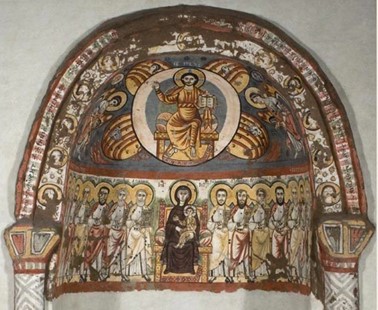By Aileen Keenan
The Coptic monastery in Bawit was founded around the year 385 AD by Saint Apollo. It reached its peak in the 7th and 8th centuries and was ultimately abandoned by the 12th century. Covering a total area of 40 hectares, it sits on the edge of a plateau at the desert’s edge, 28 kilometers from Hermopolis Magna and near the village of Dashlout. The site was rediscovered in 1901 by the Frenchman Jean Clédat in collaboration with the Institut Francais d’Archeologie Orientale. Excavations at the site, ongoing since the 20th century, have unearthed various complexes comprising residential and prayer areas. While the functions of all spaces have not been fully elucidated, two churches, communal buildings such as refectories or prayer rooms, as well as accommodation for individual monks, have been identified. Additionally, there are kitchens, storage rooms, gardens, and fields, and possibly even a school, a library, and a hospital, as indicated by textual evidence (see Clackson). The surviving wall fragments exhibit elaborate paintings, predominantly depicting saints and monks, themes from salvation history, and scenes from early Christian and Roman funerary art. Textual findings (see Clackson) partially reconstruct the daily lives of the monks: they were largely self-sufficient due to their extensive holdings and lands in the nearby and distant surroundings. The monastery held significant land possessions and employed a sophisticated tax system (see Schenke) for its management, serving as an economic hub during its existence. Culturally, the monastery is connected with the monasteries of Apa Jeremias in Saqqara and Apa Anoup, all of which venerated the same saints.
Bibliography:
- J. Clédat, Le monastère et la nécropole de Baouit, MIFAO 111 (Kairo 1999)
- S. Clackson, Coptic and Greek Texts Relating to the Hermopolite Monastery of Apa Apollo (Oxford 2000)
- A. Delattre, Intellectual Life in Middle Egypt. The Case of the Monastery of Bawit (Sixth-Eigth Centuries), in: G. Gabra – H. Takla (eds): Christiantity and Monasticism in Middle Egypt, Al-Minya and Asyut (Kairo 2013) 15–19
- G. Schenke, Monastic Control over Agriculture and Farming. New Evidence from the Egyptian Monastery of Apa Apollo at Bawit Concerning the Payment of APARCHE, in: A. Delattre – M. Legendre – P. M. Sijpesteijn (eds): Authority and Control in the Countryside. From Antiquity to Islam in the Mediterranean and Near East (6th-10th Century) (Leiden 2019) 420–431
- E. Wipszycka, The Second Gift of the Nile. Monks and Monasteries in Late Antique Egypt (Warschau 2018)

Cairo Museum Inv. No. 7118, tempera painting, 6th/7th cent.
